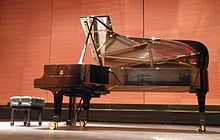Steinway Tunnel
 | |
| Track work in the tunnel in October 2011 | |
| Overview | |
|---|---|
| Line | IRT Flushing Line (7 <7> trains) |
| Location | East River between Manhattan and Queens in New York City |
| Coordinates | 40°44′48″N 73°57′48″W / 40.7468°N 73.9633°WCoordinates: 40°44′48″N 73°57′48″W / 40.7468°N 73.9633°W |
| System | New York City Subway |
| Operation | |
| Opened | June 13, 1915 |
| Operator | Metropolitan Transportation Authority |
| Technical | |
| Length | 1.3 miles (Vernon-Jackson to Grand Central) |
| No. of tracks | 2 |
The Steinway Tunnel carries the 7 <7> trains of the New York City Subway under the East River between 42nd Street in Manhattan and 51st Avenue in Long Island City, Queens, in New York City. It was originally designed and built as an interurban trolley tunnel (hence the narrow loading gauge and height), with stations near the current Hunters Point Avenue and Grand Central stations of the 7 <7> trains. It is named for William Steinway, who was a major promoter of its construction, although he died in 1896 before it was completed.
History
Construction was started in May of 1892. However, soon after the start of construction, there were many complications. The project was difficult due to complex geological formations beneath the river, and there were frequent blowouts and floods. It was curtailed for a little while when five people were killed on December 28, 1892. Work was stopped in 1893 as a result, and it was boarded up. Until Steinway died, some attempts were occasionally made to resume construction.
The project was revived in 1902 with financial support from August Belmont, Jr., who assumed the cost of building the Interborough Rapid Transit Company (IRT) and its plan of equipping and operating the first subway. Surveys and tunnel plans were prepared from scratch by the IRT. It was completed in 1907, after the city had objected to it multiple times. Some demonstration trolley car runs were conducted through the tunnels in 1907; however Belmont did not have a franchise to operate a transit line. The tunnels, with trolley loops on both the Manhattan and Queens sides, remained idle until Belmont sold them to the city in 1913.[1]
The original IRT plan was to resume trolley car operation, but this was rejected in favor of a regular rapid transit train service. The tunnels were measured, and it was found that only minor modifications were needed to allow for third rail installation. The loops and the ramp were unusable by regular subway cars due to the tight 50' radius of the loops and the steep 6% incline. However, the roadbed did not have to be lowered, nor was special low profile rail required, but the duct banks in the tunnels were replaced. The tunnels were modified to accommodate IRT subway cars in 1914. The first IRT Steinway test train between Grand Central and Vernon Avenue (today's Vernon Boulevard – Jackson Avenue station) ran June 13, 1915, with regularly scheduled service beginning June 22.[2][3]
When Belmont modified the IRT Flushing Line to extend to Times Square and to Flushing, the loops on the Queens side of the tunnel were obliterated in the wake of new construction. The loop on the Manhattan side, however, is intact and currently occupied by maintenance rooms.[4]
See also
References
- ↑ Hood, Clifton (2004). 722 miles: the building of the subways and how they transformed New York (Centennial ed.). Baltimore: Johns Hopkins University Press. pp. 163–168. ISBN 978-0-8018-8054-4. Retrieved 2009-08-26.
- ↑ "First Subway Car in Steinway Tunnel". The New York Times. June 14, 1915. p. 15. Retrieved 2010-07-02.
- ↑ "Queensboro Tunnel Officially Opened". The New York Times. June 23, 1915. p. 22. Retrieved 2010-07-02.
- ↑ http://ltvsquad.com/2012/09/04/grand-central-trolley-loop/
Further reading
| Wikimedia Commons has media related to Steinway Tunnel. |
- Rogoff, David (1960). "The Steinway Tunnels." Electric Railroads, No. 29.
| ||||||||||||||||||||||||||||||||||||||||||||||||||||||||
